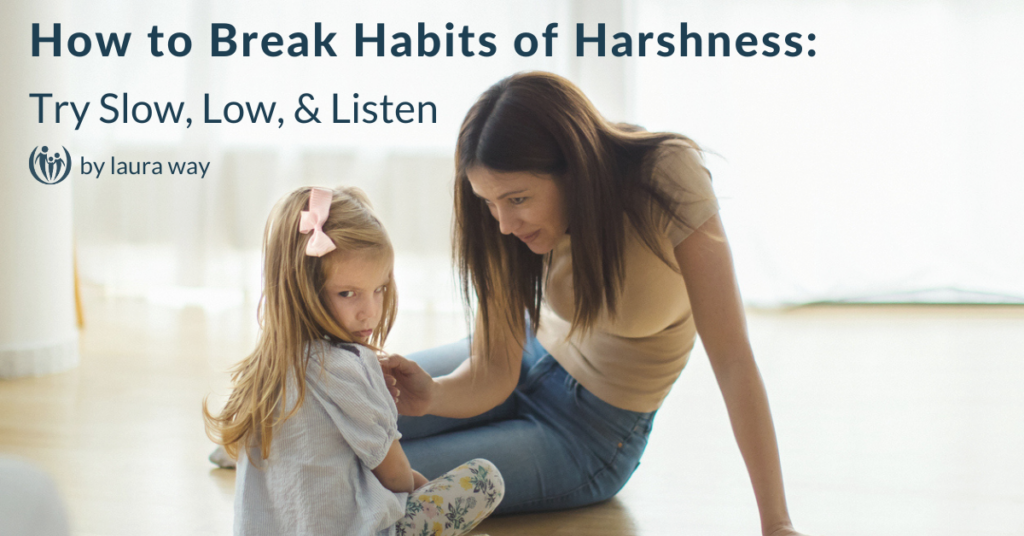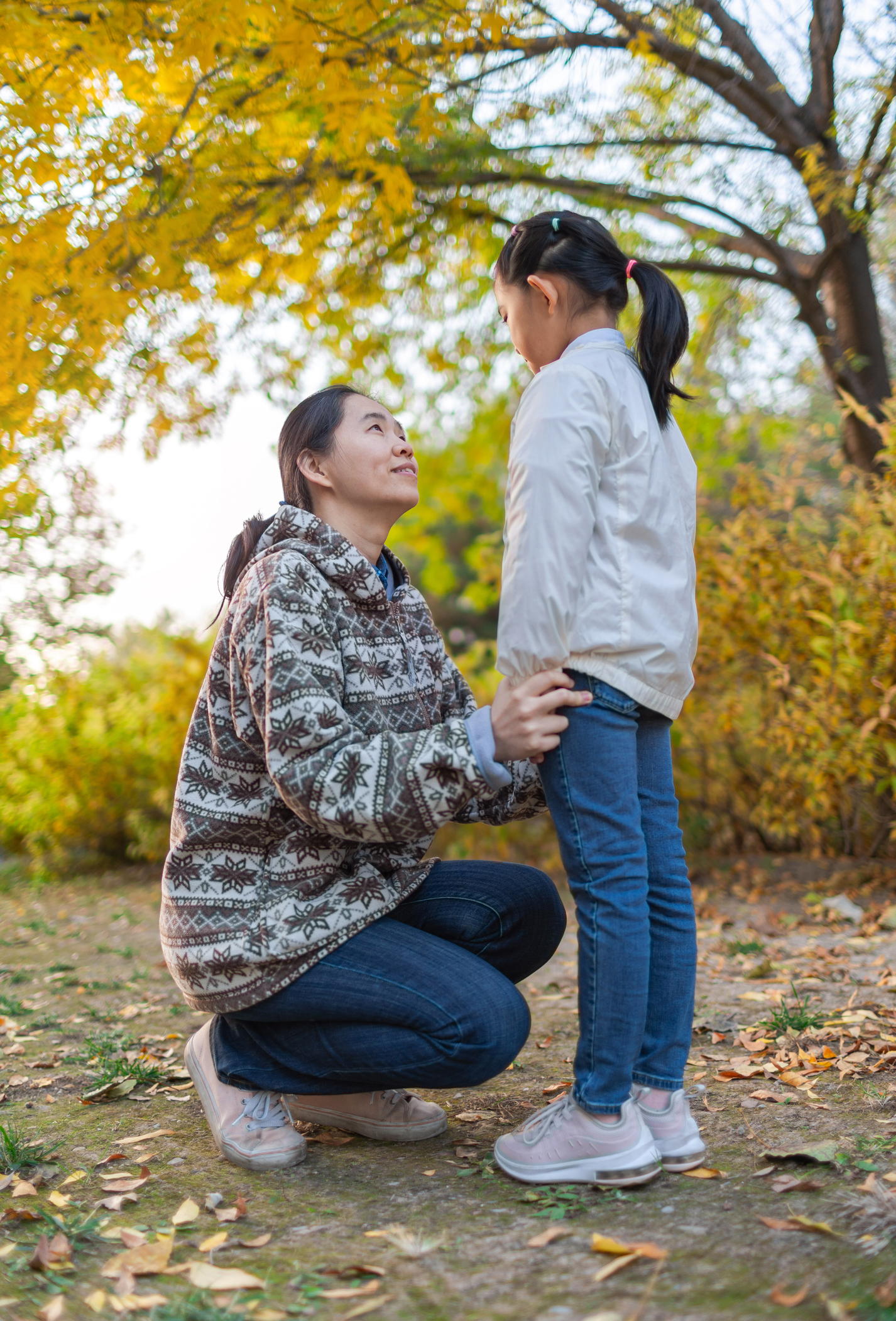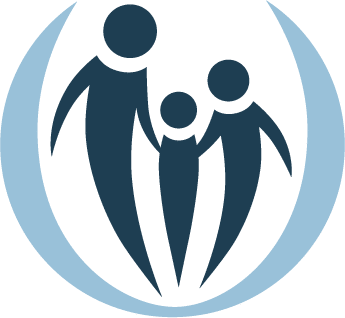
How to Break Habits of Harshness: Try Slow, Low, & Listen Next Time
3 Ways to Break Habits of Harshness

You’ve probably discovered that parenting can be wonderful, a miracle, and a gift… but also exhausting and testing your patience in ways you never thought possible. One dad nailed it: “Parenting has brought me to greater extremes of emotions than I ever imagined.” Yup. That sums it up. Exhilarating love and joy, and mind-blowing exasperation!
How have you ever felt your responses to your child were… kind of mean? You’re not alone. Every month, hundreds of parents go to search engines to type, “How to stop being mean to my child.” But, hold it right there. You’re not a mean parent! Mean is defined as “nasty, malicious, despicable.” Um, seriously, we’re not believing that describes you! So let’s just stop right here for some clear thinking and encouragement.
The opposite of being mean to your child is being kind to your child. That’s a worthy goal! Don’t embrace an identity of being mean to your child, even if you’ve had some “mean” behavior lately. That’s still not your identity! Instead, embrace an identity of being a parent working toward learning to be kinder to your child. That’s what the rest of this article is all about!
Let’s begin with a single assumption: you love your child and do not want to be “mean” or (more accurately) harsh or over-reactive to them–ever. So start with your most accurate assessment of your situation: something like, “I’m not maliciously “mean” to my child! I love my child, but if I’m stressed or tired, I can be harsh in ways I regret. I want some help.”
Unfortunately, it’s all too common to give unhelpful and unkind knee-jerk reactions when you’re exhausted, frustrated, and dysregulated. You want to be a loving, caring parent. You want to be able to respond with grace instead of reacting harshly during difficult discipline moments, but you don’t know how.
Honestly, there’s not a single answer, but if you’re struggling with unhelpful or unkind responses to your child’s struggles, don’t beat yourself up. And especially: don’t label yourself as a “mean” parent. There is hope. Having a concrete plan is incredibly helpful.
Why you might act “mean” toward your child when you never wanted to be
You likely recognize when your child becomes dysregulated, whether it’s a gradual increase in agitation or an explosive burst of anger. It’s almost as if their emotions can escalate from calm to chaos in the blink of an eye.
But it’s not just your child who gets caught up in this storm—often, their dysregulation spills over, sweeping you up in a whirlwind of frustration and urgency to make it stop. In these moments, it’s tempting to meet outbursts with a loud, reactive response. You might think, “Are we seriously doing this again?”
At this point, you’ve entered your child’s dysregulated state. You’re both dysregulated, and neither a conversation nor comfort is possible.
Before you know it, you’re both caught in the cycle of dysregulation, making meaningful conversation and comfort impossible. Whatever you say during this heightened state is likely unhelpful and, regrettably, can be unkind.
At this point, you’ve entered your child’s dysregulated state. You’re both dysregulated, and neither a conversation nor comfort is possible.
Slow, Low, Listen: the key that helped me to stop being “mean” to my child
I remember a time when, after a few attempts at getting me to say ‘yes’ to a request, my daughter’s face became red and contorted with rage, and she started to scream and cry. Any attempts at coming near her were met with hostility. Usually when this happens, I feel my body shift into shutdown mode. Thankfully, in this instance, I remembered a tool my Connected Families Certified Parent Coach had recently gone over with me: Slow, Low, & Listen.
I sat down on my kitchen floor, facing my 7-year-old daughter, and noticed a brief expression of surprise across her face. I said nothing while I took a few deep breaths. I was relieved to feel that sitting down seemed to signal to my body that this was not a crisis. She joined me on the floor, continuing to cry and make her requests (demands) known, but I was able to keep my voice calm and kind.
I did my best to communicate empathy—I knew what she wanted and why, and I knew not getting it made her sad. We rode out the waves of the big feelings together and then moved on with our evening. I couldn’t wait to tell my coach: “I used Slow, Low, & Listen, and it helped both me and my daughter navigate a difficult outburst!”
The science behind Slow, Low, & Listen
God designed your brain to respond to threats instantaneously. When there is a real danger, your nervous system serves you well by bypassing your slower, more complex frontal lobe function (where we access our logical, problem-solving skills). Instead, it focuses its energy on getting you out of danger! This is what you probably know as fight-flight-freeze. It’s a natural emergency response.
Unfortunately, sometimes your brain isn’t always great at knowing the difference between a real emergency (like a bear!) and a child screaming at you. Similarly, it’s sometimes hard for a child to discern a real threat (like a bee sting!) from their caregiver saying “No” to a request.
If you were really in danger, your body might use a Fast, Large, & Loud (“fight”) action to defend yourself. This is often where your child’s body goes when they’re dysregulated. It’s also where you might naturally go when responding to your child’s Fast, Large, & Loud responses. Their emergency response triggers your own emergency response.
As parents, you can break this escalating cycle, but first you’ve got to slow yourself down! Otherwise, you’ll run into the situation with all the energy of a bear chasing you up a tree. You can defuse tense situations like these with your kids by choosing to approach them with the opposite of Fast, Large, & Loud; instead, you can go Slow, get Low, & Listen to your child.
The beauty of Slow, Low, & Listen is that it’s a powerful tool for both parent and child. That’s what surprised me most that day in the kitchen—how slowing down and simply sitting quietly helped my body stay calm and regulated. My brain knows I would not be sitting down if there was any imminent danger, so it allowed me to begin to think again with my upper brain (which doesn’t want to be “mean” to my child!).
Their emergency response triggers your own emergency response.
How to use Slow, Low, & Listen
First, let’s remember: This tool is about you. It’s all about your responses and what’s going on inside you. The goal is to get you regulated so that you can help your dysregulated child. It can help you tame your anger and stop harsh responses to your child, but it can do so much more. It’s also about connecting with your child in their most vulnerable moments when they’re struggling. Before you can effectively help your child work through their behavior, you have to deal with you.
The Connected Families Framework calls this your Foundation – it’s the source of your responses to your child. So, how do you use this tool to develop the habit of showing compassion to your child instead of harshness?
Go SLOW: Buy yourself some time
Slow down and invite the Holy Spirit into the moments. If you’re in the habit of saying harsh words or reacting poorly when your kids misbehave, take a few deep breaths and give your brain a moment to realize this isn’t an emergency.
Of course, sometimes it is an emergency, such as when a sibling aims a brick at another, a toddler runs toward the swimming pool without an adult or a life jacket, or your child simply decides to make a smoothie without the lid to the blender. In those cases, let your emergency response do what it’s good at: moving quickly and with big energy. Save your correction and teaching for after the danger is cleared and when you can better SLOW down.
It doesn’t have to be complicated. Because children mirror our response and behavior, any action you take to stop yourself from running into the moment of correction with your initial reaction will work. Slowing down might be as simple as putting your hands in your pockets or behind your back, taking a step back, or leaning against the wall. It might be taking a bathroom break or doing a few pushups. Take a moment to sip ice water from a straw or rub lotion into your hands. It might involve doing some breath prayers or breathing exercises. (You can invite them to join you, but they will likely not be willing if they are already significantly dysregulated.)
We have have a podcast about this!
If you’d prefer to listen to this content in podcast form check out, “Want to Stop Yelling at Your Kids? Try Slow, Low, & Listen”
Get LOW: Your brain listens to your body
You can help your body stay calm and regulated by intentionally choosing positions of relaxation: sitting down, leaning back, and even propping your feet up. Your bodily position tells your brain there isn’t an imminent threat, and it allows the flight-fight-freeze response to fade. If possible, put yourself in a position at eye level or even below your child. This communicates to your child’s nervous system that you are not a threat.
Early on in my journey to regulate my own nervous system, I would often go immediately into shutdown, lying down on my daughter’s bed while we talked. While this wasn’t the calm and connected posture I knew I was working towards, I noticed it did de-escalate those situations faster than barking orders from the door.
Slow to speak & quick to LISTEN
I don’t know about you, but my tendency is to lecture and use a lot of words. The problem is that when your kids are dysregulated, words don’t “work.” Remember: the logic and problem-solving parts of their brain are literally offline. In fact, research shows that “[emotions] can inhibit learning by blocking these cognitive processes in the face of threat.” Lecturing a dysregulated child usually leads to frustration on both sides—you sense they’re not truly listening (because they can’t), and they feel shamed or controlled.
Speaking fewer words in a calm voice opens up the opportunity for listening. (As opposed to harsh or dismissive demands to “Just stop it,” or “Calm down!”) By genuinely listening to and seeing your child, you communicate, “You are SAFE with me.” Notice your face and see if you can relax your expression into one of empathy and love. You want to be ready to listen not only to your child’s feelings but to the Lord’s leading.
In your silence, ask God:
- “Lord, what’s the opportunity here?”
- “Lord, give me your heart for my child.”
- “What’s the need driving this challenge?”
- “What’s it like to be my child right now?”
- Repeat your prepared “grace-filled truth.”
- Pray silently or out loud for wisdom and grace.
- Post a key scripture. Repeat it.
James 1:19-20 says, “Everyone should be quick to listen, slow to speak and slow to become angry, because human anger does not produce the righteousness that God desires.” Jesus, our Prince of Peace, often modeled Slow, Low, & Listen in His interactions with people. (Think of the example of the woman caught in adultery. In an intense conflict, He stoops down to draw in the sand, and this non-threatening response helps to defuse the angry mob.
Once your children feel safe with you, their bodies can begin to regulate and regain access to their frontal lobes and the ability to think clearly and to learn. Not until then can you effectively begin to do whatever Coaching or Correcting may be necessary.
FREE Printable PDF
Don’t want to forget Slow, Low, & Listen when life gets crazy? Download and print this “Slow, Low, & Listen” PDF. Post it in a visible spot or save it to your phone for quick reference.
Practice Slow, Low, & Listen — again and again!
Has a child of yours told you lately that you’re “mean” (which sometimes happens even if you’re not)? If you often approach your child’s misbehavior or big emotions with Fast, Large, & Loud energy, take heart. You’re not alone. Slow, Low, & Listen is a tool you can practice over time. If you want kindness to guide your actions with your children, start with Slow, Low, & Listen.
One dad struggled to remember these steps, so he wrote Slow, Low, & Listen on his hand. When he was heading angrily toward a misbehaving child, a compassionate sibling said, “Dad! Look at your hand!” Peace prevailed in his response, and he gradually learned that new habit.
While you learn, practice, and grow in these skills, you’re also modeling regulation for your child. As this process is repeated with a sense of safety and love, it gradually builds trust and self-regulation skills in your child.
I don’t always remember to enter into challenging situations in my home in a posture of Slow, Low, & Listen. But I know that when I do, I am better able to communicate the messages I long for my child to hear:
- “You are SAFE with me.”
- “You are LOVED no matter what.”
- “You are CALLED & CAPABLE.”
- “You are RESPONSIBLE for your actions.”
Maybe that’s because when I SLOW down, get LOW, and seek to LISTEN, I am better able to receive these messages from my Heavenly Parent:
- “I am SAFE and can be okay even when my child is not.”
- “I am LOVED no matter what, even in this struggle.”
- “I am CALLED & CAPABLE of parenting this child to become who God is calling her to be.”
- “I am RESPONSIBLE for my own actions in this interaction. If I blow it, I can repair it!”
Always remember: God is with you in these moments with mercy and help!
© 2025 Connected Families

How to Turn Fast, Large, & Loud into Slow, Low, & Listen Mini-Course
Struggling with yelling at your kids?
Transform your approach in just 10 minutes a day for four days with this mini-course. Blend brain science, biblical wisdom, and “slow, low, and listen” strategies to foster a safer connection with your children.

